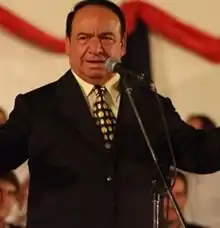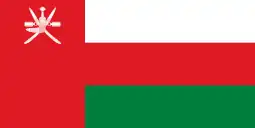Sabah Fakhri صباح فخري | |
|---|---|
 Fakhri performing in March 2004 | |
| Background information | |
| Birth name | Sabah al-Din Abu Qaws |
| Born | May 2, 1933 Aleppo, Syria |
| Died | November 2, 2021 (aged 88) Damascus, Syria |
| Genres | Syrian, Arabic Music, Muwashahat, Qudud Halabiya |
| Occupation(s) | Singer |
| Instrument(s) | Vocals |
| Years active | 1965–2010 |
Sabah al-Din Abu Qaws (Arabic: صباح الدين أبو قوس), also known as Sabah Fakhri (Arabic: صباح فخري North Levantine Arabic pronunciation: [sˤɑbɑːħ fæxɾiː]; May 2, 1933 – November 2, 2021), was a Syrian tenor singer from Aleppo.
With over 50 years of fame and popularity as a singer, Sabah Fakhri modified and popularized the then-fading forms of traditional Arabic music Muwashahat and Qudud Halabiya. He was well known for his beautiful strong vocals, impeccable control and execution of Maqamat and harmony, as well as his dominant and charismatic performances on stage. In the Arab world, he is regarded as one of the greatest artists of all time.
Biography
Sabah was born in Aleppo Syria 1933 and enrolled in the Academy of Arabic Music of Aleppo. He later studied at the Academy of Damascus, from which he graduated in 1948. He was given the stage name "Fakhri" by his mentor, Syrian nationalist leader Fakhri al-Barudi, who encouraged him as a young boy to stay in Syria and not travel to Italy. One of Fakhri's earliest performances was in 1948 at the Presidential Palace in Damascus, before President Shukri al-Quwatli and Prime Minister Jamil Mardam Bey. Unlike many Arab artists, he never studied or worked in Cairo, insisting that his fame is linked to the artistic heritage of his homeland, Syria.
Sabah Fakhri was one of the very few singers from Arabic-speaking countries to have reached widespread popularity by singing in the Arabic language (including Europe, Asia, the Americas, and Australia). His name is enshrined in the Guinness Book of Records for his prowess in Caracas, Venezuela, where he sang continuously for 10 hours without pause.[1]
In 1998, Fakhri became a member of the Syrian parliament for the session, as a representative of artists.[2]
Interaction with the audience
When he performed, Fakhri insisted on interacting with his audience. Before singing, he insisted on having a good atmosphere by having good musicians and an appropriate sound system. While performing he asked for the lights to remain on, to interact with the audience. He said that the audience played a key role in bringing out the performer's creativity. The audience should be aware of the music and poetry, so they would value the music given to them.[3]
Death
Fakhri died on November 2, 2021, in Damascus, aged 88.[4][5]
Major works
Fakhri sang many traditional songs from Aleppo, based on the poems of Abu Firas al-Hamdani, Al-Mutanabbi and other poets. He also worked with contemporary composers. Some of his most popular songs are:
- Yā Hādī al-‘Ess / Mālek Yā Ḥelwa(t) Mālek
- Khamrat el-Ḥobb
- Yā Ṭīra(t) Ṭīrī
- Fōg el-Nakhal (Iraqi song)
- ’Adduka al-Mayāss
- Yā Māl el-Shām
- Muwashshaḥ Imlīlī / Yā Shādī el-Alḥān
- Eba‘atlī Jawwāb
- Ah Yā Ḥalō
Awards
On 12 February 2007, Fakhri was awarded the Syrian Order of Merit of Excellent Degree by the Syrian president Bashar al-Assad in recognition of his achievements in serving and his role in reviving the artistic heritage of Syria.
Honors
 Lebanon: Commander of the National Order of the Cedar.
Lebanon: Commander of the National Order of the Cedar. Morocco: Grand Cordon of the Order of Ouissam Alaouite.
Morocco: Grand Cordon of the Order of Ouissam Alaouite. Oman: Grand Cordon of the Order of Civil Merit.
Oman: Grand Cordon of the Order of Civil Merit. Syria: Grand Cordon of the Order of Civil Merit.
Syria: Grand Cordon of the Order of Civil Merit. Tunisia: Grand Cordon of the National Order of Merit[6]
Tunisia: Grand Cordon of the National Order of Merit[6]
References
- ↑ Sabah Fakhri: Straight to the heart, Profile by Fayza Hassan Archived August 17, 2008, at the Wayback Machine
- ↑ "Articles On Members of the Syrian Parliament". flipkart.
- ↑ In the Course of Performance: Studies in the World of Musical Improvisation, edited by Bruno Nettl, Melinda Russell
- ↑ "Sabah Fakhri, Syrian tenor who helped preserve classical Arabic music, dies at 88". The Washington Post. November 2, 2021. Retrieved June 11, 2022.
- ↑ "Syrian singer Sabah Fakhri dies aged 88: 'The light of music went out in the Levant'". The National News. November 2, 2021.
- ↑ "Tunisie: Sabah Fakhri décoré du plus grand insigne de la médaille de l'Ordre du mérite culturel". March 22, 2015.
External links
- Sabah Fakhri Home Page
- Sabah Fakhri discography at Discogs